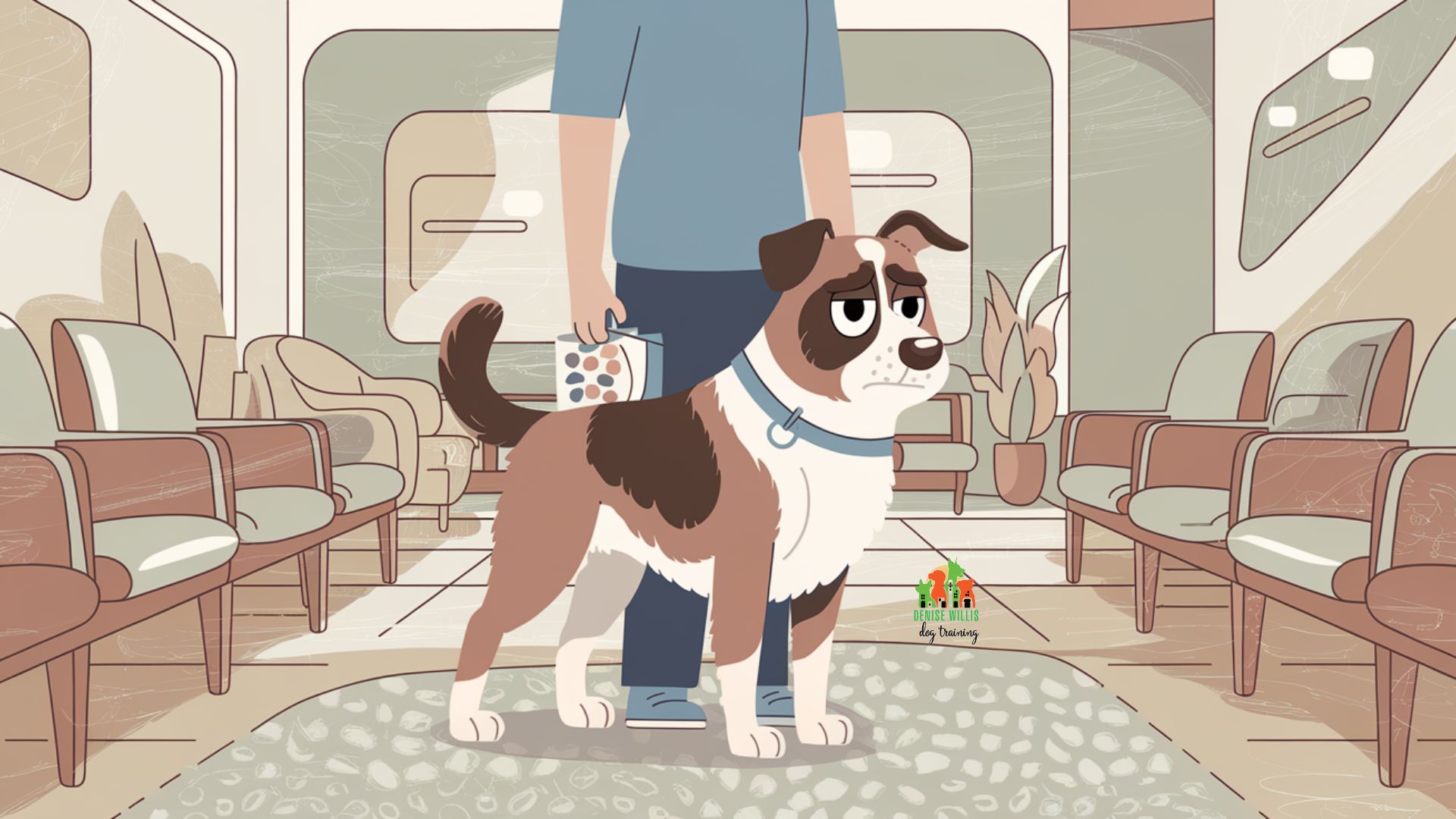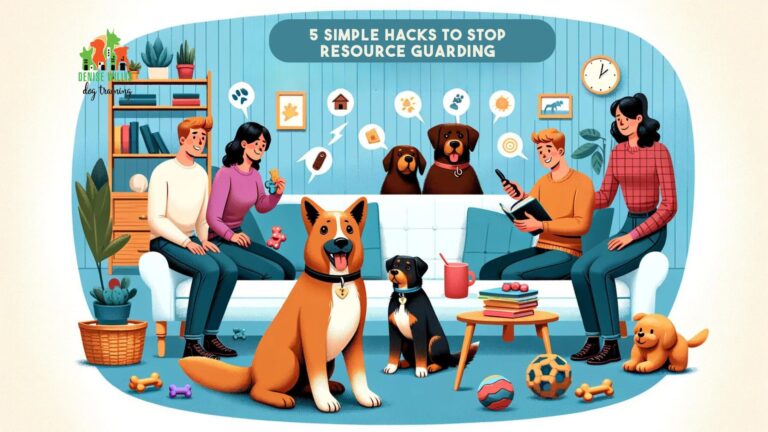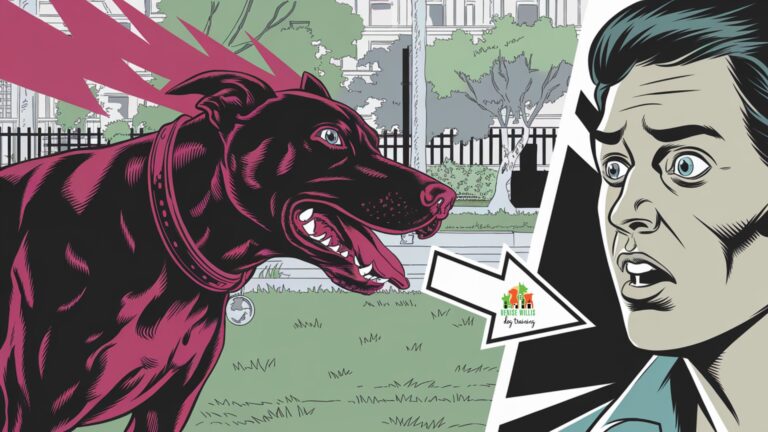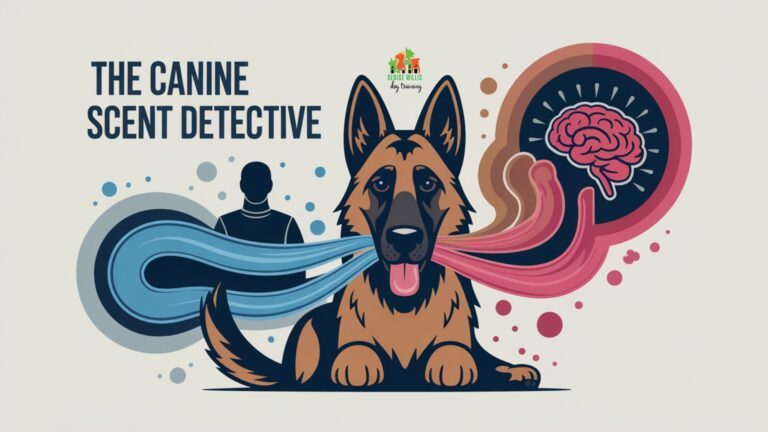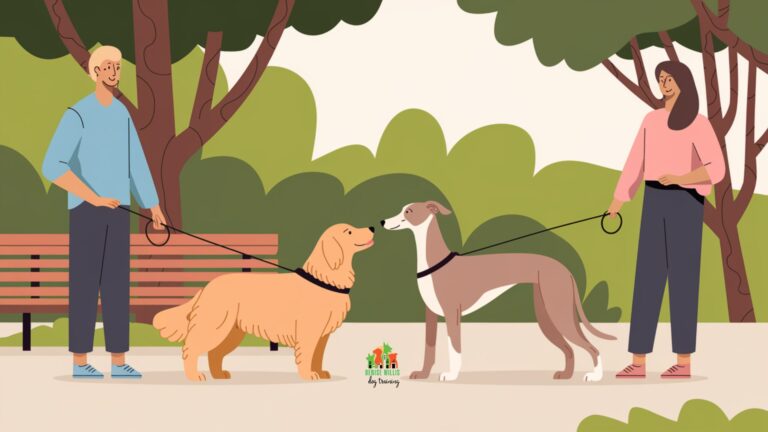No More Nightmares: Managing Dog Aggression During Vet Visits
📍 Service Area Notice: DW Dog Training provides in-person training services exclusively in the Greater Baltimore area. While our blog content is designed to help dog owners internationally, our hands-on training services are locally focused. For readers outside our service area, we hope you find value in our articles and welcome you to reach out with questions!
Your normally sweet, tail-wagging companion just pulled their best impression of a horror movie character the moment you pulled into the veterinary clinic parking lot.
Sound familiar?
You’re not alone in this veterinary visit drama. Recent studies from VCA Animal Hospitals show that approximately 1 in 5 dogs exhibit signs of aggression during vet visits. But before you cancel all future appointments and consider becoming a veterinarian yourself (trust me, that’s a bit extreme), you should consider tackling this challenge head-on.
Key Takeaways
- Recognize subtle stress signals before they escalate into full-blown anxiety
- Master the art of preparation (because winging it rarely works with worried pups)
- Transform vet visits from horror shows into manageable adventures
- Build a solid partnership with your veterinary team
- Create lasting solutions that work for everyone involved (including that nervous receptionist)
Mastering the Vet Visit: Your Guide to Stress-Free Care
Know Your Dog’s Signs
78.5% of dogs show stress on exam tables. Learn to spot early warning signs like lip licking, yawning, and the famous “whale eye” before anxiety escalates.
Practice Makes Progress
Create positive associations through “happy visits” to the clinic. Practice handling exercises at home using high-value treats as rewards.
Smart Timing
Schedule appointments during quiet hours, arrive with just enough time to settle, and use waiting room strategies to minimize stress.
Build Your Toolkit
From calming supplements to favorite toys, create a personalized comfort kit for less stressful veterinary visits.
Reading Your Dog’s Stress Signals
Think of your dog’s stress signals like a traffic light system – green means all clear, yellow suggests caution, and red… well, that’s when things get interesting. The secret lies in catching those yellow lights before they turn red.
The Silent Language of Stress
Remember that time you tried to hide your nervousness during a job interview, but your leg wouldn’t stop bouncing? Dogs have their own version of nervous tics, and research from the Dog Trust has mapped out these subtle signs in fascinating detail:
- The Not-So-Sleepy Yawn: When your dog yawns at the vet, they’re not critiquing the waiting time. This stress yawn looks different – it’s more intense, often accompanied by a high-pitched whine.
- The Phantom Lick: Notice your pup licking their lips when there’s not a treat in sight? That’s like your nervous dry-mouth before a presentation.
- The Avoidance Dance: Suddenly finding the corner of the room absolutely fascinating? Classic avoidance behavior. It’s your dog’s polite way of saying, “I can’t even…”
- The Freeze Frame: If your typically bouncy buddy turns into a statue, they’re not practicing for a game of Red Light, Green Light. This stillness often precedes more serious stress responses.
Pro Tip: Ever notice how stress seems contagious? Studies published in PMC show that dogs can pick up on their owner’s anxiety. So, maybe skip that triple espresso before the vet visit!
The Numbers Don’t Lie: You’re Not Alone in This
Think your pup’s the only one doing their best drama queen impression at the vet? Grab your reading glasses (and maybe a calming treat for yourself), because these numbers might just make you feel a whole lot better about your dog’s veterinary ventures.
| Behavior Type | Percentage | Notes | Source |
|---|---|---|---|
| Severe Fear Response | 14% | Dogs showing extreme or severe fear during vet examinations | [PMC Study] |
| Examination Table Fear | 78.5% | Canine patients showing fearful behavior on examination tables | [DVM360] |
| Waiting Room Stress | 29% | Dogs exhibiting ‘extreme’ stress in veterinary waiting rooms | [DVM360] |
| Regular Vet Visits | 40.1% | Dog owners taking their pets to the vet twice yearly | [AVMA] |
| Owner Behavior Reading | 61% | Owners rating their ability to read dog behaviors as “good” | [AVMA] |
Plot twist: that examination table that turns your brave guardian into a quivering mess? It’s doing the same thing to about 8 out of 10 other pups! These numbers aren’t just statistics – they’re a reminder that you’re part of a much bigger pack of pet parents navigating the challenge of veterinary visits. And here’s the good news: now that we know what we’re dealing with, we can do something about it.
Quick Pro Tip: Share these stats with your vet! Nothing builds a better partnership than understanding you’re both working with the same playbook.
Beyond the Basics: Advanced Stress Signals
Let’s dig deeper into those less obvious signs that your pup is reaching their limit. Think of these as your early warning system:
Physical Changes
- Subtle muscle tension (especially around the mouth)
- Changes in breathing patterns (quick, shallow breaths)
- Raised hackles that make your smooth-coated friend look like they stuck a paw in an electrical socket
- That famous “whale eye” look where you see more white than usual
Behavioral Shifts
- Excessive sniffing (because apparently, that floor is suddenly fascinating)
- The “I’m too busy to look at you” routine
- Subtle weight shifts away from approach
- That oddly polite sitting behavior that seems out of character
Remember: Your dog isn’t being “bad” or “difficult.” According to veterinary behavior experts, these reactions stem from genuine fear and anxiety. It’s like when you grip the dentist’s chair a little too tightly – nobody judges you for that, right?
The Pre-Visit Preparation Protocol
Think of preparing for a vet visit like training for a marathon, except your running partner has four legs and might need more convincing about the whole “this is good for you” thing.
Setting the Stage for Success
Creating a positive association with vet visits starts long before you pull into that parking lot. Here’s your game plan:
Home Training Sessions
Start with these foundation exercises:
- The Handling Olympics
- Practice gentle restraint while dispensing high-value treats
- Mix up your touching routine (ears, paws, tail)
- Make it a daily game rather than a training chore
- Keep sessions short and sweet (think commercial break length)
- Mock Examinations
- Create a designated “exam spot” at home
- Use a non-slip mat similar to exam table surfaces
- Practice lifting exercises (if your back permits)
- Reward calm behavior generously
Veterinary professionals note that dogs who receive regular handling practice at home show significantly less stress during actual examinations.
The Art of Muzzle Training
Now, before you skip this section faster than your dog bolts from bath time, hear me out. Muzzles aren’t about punishment. They’re about prevention and peace of mind. Think of a muzzle like a bike helmet. Nobody questions wearing one during a cycling adventure, right?
Making Friends with the Muzzle
- Start by letting your dog investigate the muzzle like it’s a fascinating new toy
- Pair every muzzle interaction with treats that would make Gordon Ramsay jealous
- Practice short durations (we’re talking seconds, not your Netflix binge-watching sessions)
- Gradually build up tolerance like you’re training for a marathon
The ASPCA’s behavior specialists emphasize that proper muzzle training can take weeks, but the payoff is worth every minute.
The Big Day: Making Vet Visits Manageable
Remember that feeling before your first driving test?
The butterflies, the sweaty palms, the conviction that everything would go horribly wrong?
Your dog feels something similar about vet visits, minus the worry about parallel parking.
Strategic Arrival Planning
Your game plan starts before you leave home. VCA Hospitals research shows that arrival timing can make or break your visit.
The Perfect Timing Playbook
- Schedule appointments during off-peak hours (think Tuesday afternoon, not Saturday morning rush)
- Arrive with enough time to decompress but not enough to spiral into anxiety
- Consider requesting the first appointment of the day (fewer lingering scents from other pets)
- Plan for post-visit decompression time (no rushing back to Zoom meetings)
Quick Pro Tip: That parker spot way in the back? It’s not just good for your step count. It gives your dog a chance to shake off some nerves before heading inside.
The Waiting Game Reimagined
The waiting room doesn’t have to feel like a pressure cooker of canine anxiety. Here’s your survival guide:
Create Your Bubble of Calm
- Find your spot (preferably with a wall at your back)
- Maintain personal space (think social distancing, but make it permanent)
- Keep your dog occupied with gentle tasks they enjoy
- Use calming signals yourself (slow blinks, calm breathing, relaxed shoulders)
Research from veterinary behaviorists suggests that even brief positive experiences in the waiting room can significantly impact future visits.
In the Exam Room: Your Moment to Shine
You’ve made it past the waiting room gauntlet, and now it’s showtime. But don’t worry. You’ve got more backup than a superhero movie finale.
Setting Up for Success
Think of the exam room like a stage. Everything needs to be in the right place for the best performance.
The Exam Room Dance
- Position yourself where your dog can see you (you’re their emotional support human, after all)
- Keep treats readily available (but not so available that they end up all over the floor)
- Maintain a calm demeanor (channel your inner yoga instructor)
- Be ready to advocate for your dog’s needs (you’re their voice, use it wisely)
Communication: The Secret Weapon
Remember that time you tried to assemble furniture without reading the instructions? That’s what trying to handle vet visits without proper communication feels like. Veterinary practice studies show that clear communication between pet parents and medical staff can reduce stress incidents by up to 50%.
Your Communication Checklist
- Share your dog’s triggers (because surprise parties are fun, surprise reactions aren’t)
- Discuss handling preferences (some dogs are like Tetris pieces – they need to be approached just right)
- Ask about alternative examination positions (who says all exams need to happen on the table?)
- Request breaks when needed (it’s a marathon, not a sprint)
Pro Tip: Take notes during the visit – not just about medical stuff, but about what worked and what didn’t. Your future self will thank you!
When Things Get Rocky
Even with perfect preparation, sometimes things don’t go according to plan. Maybe your dog decides today’s the day they’ll audition for a dramatic role in the local theater group. Don’t panic!
Emergency Protocol
- Signal the vet team if you notice escalating stress signs
- Have a pre-discussed “timeout” signal with your veterinarian
- Know when to reschedule (sometimes discretion is the better part of valor)
- Keep emergency supplies handy (extra high-value treats, favorite toy, backup leash)
Emergency veterinary specialists recommend establishing these protocols before they’re needed – kind of like knowing where the fire extinguisher is before you attempt that fancy flambé recipe.
Long-Term Solutions: Building a Better Tomorrow
Remember how you didn’t become a master of parallel parking overnight?
(Some of us are still working on that one.) Similarly, creating a fear-free vet experience takes time, patience, and sometimes a few U-turns.
The Science of Change
Your dog’s brain is surprisingly similar to a GPS system. It can be reprogrammed to take new routes when the old ones aren’t working. Veterinary behaviorists at the University of Pennsylvania have documented remarkable success with systematic behavior modification.
The Building Blocks of Better Behavior
- Start with baseline stress levels (your dog’s normal “operating temperature”)
- Identify specific triggers (the what, when, and why of anxiety)
- Create graduated exposure plans (baby steps win marathons)
- Track progress systematically (because data is beautiful)
Pro Tip: Keep a “vet visit diary”. It’s like a training journal, but with more tail-wag metrics and fewer protein shake recipes.
Medical Management: When Training Needs Backup
Sometimes, even Olympic athletes need a little help from modern medicine. The same goes for our four-legged friends. Clinical studies show that appropriate medication can create a window of opportunity for behavioral modification.
Understanding Medical Options
- Situational anxiety medications (for specific events)
- Long-term anxiety management (when needed)
- Natural supplements and alternatives
- Combination approaches for optimal results
Remember: Medication isn’t admitting defeat. It’s adding another tool to your toolbox, like using training wheels while learning to ride a bike.
From Puppy Panic to Professional Patient: Your Dog’s Vet Visit Journey
The Puppy Chronicles (0-6 months)
Think of this as your pup’s “first impressions” phase – where every vet visit can be a tail-wagging adventure instead of a drama festival. Start with “happy visits” where nothing scary happens (just treats and pets!). The key is making these early experiences so positive that your puppy thinks the vet’s office is basically a fancy spa with extra snacks.
The Teenage Drama Years (6-18 months)
Ah, adolescence – when your sweet puppy might suddenly decide the thermometer is their archnemesis. This is prime time for developing opinions about everything, including vet visits. Time to double down on positive reinforcement and maybe start practicing with that muzzle (think of it as their superhero mask!). Remember: treats solve most teenage rebellions.
The Young Adult Phase (1.5-3 years)
Welcome to peak “I know what this place is” territory! Your dog has figured out that this isn’t just a fancy treat dispensary. But fear not – this is also when consistent training really starts to pay off. Your secret weapons? High-value treats that would make a food critic jealous and a pre-visit routine smoother than your morning coffee run.
The Seasoned Pro Years (3-7 years)
By now, you’re probably rocking a solid twice-yearly vet visit routine. Your dog might not be sending the vet Christmas cards, but they’ve probably figured out that cooperation gets them home faster (and with more treats). Pro tip: Keep up with those anxiety management strategies – they’re like your dog’s personal zen toolkit!
The Golden Years (7+ years)
Your distinguished senior might need more frequent vet visits, but they’re basically a professional patient by now. They’ve mastered the art of the dignified vet visit, even if they still need their emotional support human (that’s you!) by their side. Keep those positive reinforcement techniques going – because old dogs might not need new tricks, but they sure love their treats!
Advanced Techniques for the Dedicated Pet Parent
Ready to take your vet-visit game to the next level?
These advanced strategies are like those of the graduate school of canine cooperation.
Environmental Modification Magic
Your environment shapes your experience. Just ask anyone who’s tried to relax in a room playing death metal at full volume. Environmental psychology studies show that subtle changes can have profound effects.
Creating Calming Spaces
- Use pheromone products strategically (science-backed comfort in a spray)
- Control the soundscape (white noise can be your best friend)
- Manage lighting and temperature (comfort is in the details)
- Create predictable patterns (routine is your secret weapon)
The Power of Professional Partnerships
Sometimes you need to call in the cavalry and that’s okay! Professional help isn’t just for extreme cases; it’s for anyone who wants to give their dog the best possible care experience.
Building Your Support Team
- Veterinary behaviorist consultations
- Professional trainer collaboration
- Regular vet team meetings
- Progress evaluations and adjustments
Product Recommendations
Preparing for a vet visit shouldn’t feel like gearing up for an episode of “Mission: Impossible.” But since we can’t exactly explain to our four-legged friends that thermometers aren’t alien probes, here’s your ultimate toolkit for turning those veterinary ventures from panic to peaceful!
- ThunderShirt Sport Dog Anxiety Jacket: Like a therapeutic hug in a jacket, this pressure wrap turns your nervous nellie into a zen master. The snug fit provides constant, gentle pressure that’s like having a thousand tiny therapy sessions at once. Warning: May cause excessive relaxation and unexpected napping in previously alert guard dogs.
- VetriScience Composure Calming Chews: These bite-sized bits of tranquility pack a powerful punch of relaxation without the zombie-dog side effects. Made with thiamine, colostrum, and L-theanine, it’s like a spa day in a treat. Perfect for pre-vet visit jitters or any time your pup needs to channel their inner yoga instructor. Warning: May cause your dog to start judging your own stress-management techniques and suggesting you try meditation.
- Zylkene Behavior Support Capsules: These milk-protein based supplements are like chill pills for your furry friend, minus the prescription. Derived from casein, they help maintain that “just finished a warm bowl of milk” calm. Warning: Dog may attempt to convince you they need these sprinkled on everything, including their water.
- KONG Classic Dog Toy: The Swiss Army knife of distraction tools. Fill it with treats, and suddenly your dog thinks the vet’s office is better than Disney World. Perfect for keeping busy minds occupied while waiting for the doc. Caution: May turn your previously alert watchdog into a focused food puzzle enthusiast.
- Lickimat Calm Classic: This textured mat turns regular treats into an engaging game of “find every last molecule of peanut butter.” It’s like giving your dog their own smartphone to scroll through during waiting room anxiety. Warning: Your dog might start expecting all meals to be served as interactive entertainment.
While these products won’t magically transform your vet-visiting vigilante into a peaceful zen master overnight, they’re reliable sidekicks in your quest for calmer care visits. Think of them as your own personal utility belt of tranquility tools!
Further Reading
Think you’ve mastered the art of vet visit victory? Hold onto your leashes, because we’re about to take a deeper dive into the world of canine confidence-building. Warning: Side effects may include becoming the neighborhood’s go-to dog whisperer!
- Environmental Triggers for Dog Aggression: Ever wonder why your brave backyard defender turns into a trembling mess at the vet? This guide decodes the mystery behind location-specific anxiety. Spoiler alert: It’s not because they’re plotting an elaborate escape plan.
- 10 Warning Signs Your Dog Might Bite and How to Prevent It: Because nobody likes surprise taste-tests of human fingers. Learn to read your dog’s stress signals faster than your favorite Netflix series. Bonus: Includes fewer plot twists but more practical solutions!
- Decoding Your Dog: 15 Body Language Signals You Need to Know: Finally, a translation guide for all those subtle (and not-so-subtle) hints your dog’s been dropping. It’s like having a canine version of Google Translate in your pocket.
- How to Help Your Scaredy Dog: 6 Common Dog Phobias and Their Solutions: Because sometimes even the bravest dogs need a confidence boost. Turn your fearful Fido into a self-assured superstar with these proven techniques.
- The Shy Dog’s Guide to Conquering Fear: 10 Simple Techniques: Transform your timid pup into a social butterfly (okay, maybe just a less anxious butterfly). Perfect for dogs who think the vet’s office is secretly run by squirrels in lab coats.
Ready to become a certified expert in canine confidence? These articles are your roadmap to success, packed with more wisdom than a pack of wise old dogs.
Test Your Knowledge: Mastering the Vet Visit Challenge
Frequently Asked Questions About Dog Aggression During Vet Visits
Q: My dog was fine at the vet until one bad experience. Can we recover?
A: Absolutely! Behavioral research shows that while one negative experience can create fear, systematic positive experiences can rebuild confidence. Think of it like getting back on a bike after a fall - with proper support and patience, trust can be restored.
Q: Should I try herbal remedies before prescription medications?
A: Always discuss supplement options with your veterinarian. While some natural alternatives show promise, not all are created equal, and what works for one dog might not work for another.
Q: How do I know if my dog's aggression is fear-based or something else?
A: Fear-based aggression typically comes with specific body language cues. Your veterinarian or a certified behaviorist can help evaluate the root cause and create an appropriate treatment plan.
Final Thoughts: Your Journey to Better Vet Visits
Remember, creating positive vet experiences is like mastering any skill. It takes time, patience, and sometimes a few detours along the way. The goal isn't perfection; it's progress.
Share Your Story
At DW Dog Training, we believe every successful vet visit, no matter how small the victory, deserves celebration. Whether your dog graduated from total panic to mild concern or went from growls to tail wags, we want to hear about it!
Connect with us to share your journey, get personalized support, or simply join a community of pet parents who understand the challenges and triumphs of creating positive vet experiences.
Pro Tip: Success often looks different for each dog. Celebrate your unique victories, no matter how small they might seem to others. After all, today's tiny tail wag might be tomorrow's full-body wiggle of joy at the vet's office!

